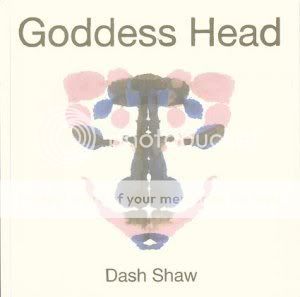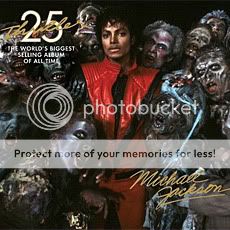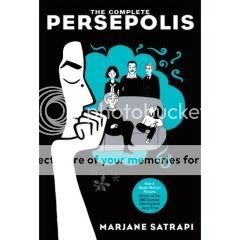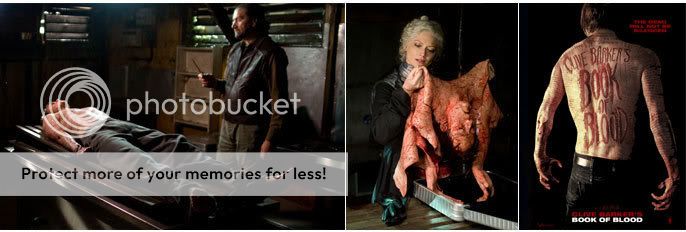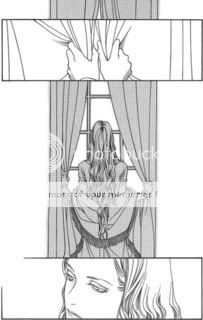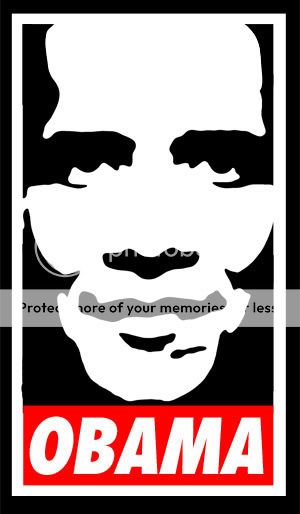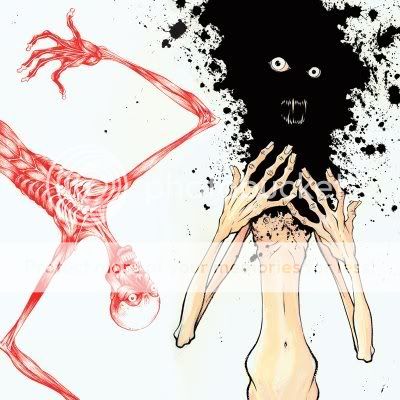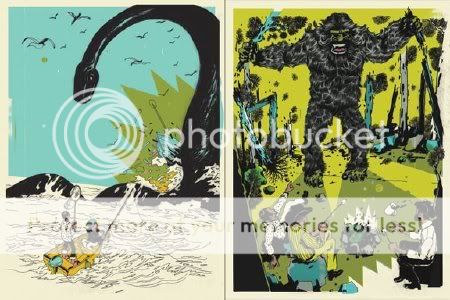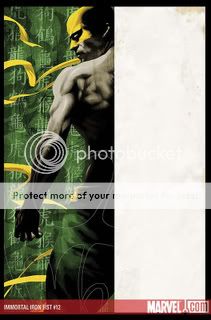Archive for February 14, 2008
Carnival of souls
February 14, 2008* Kristin Dos Santos has the final word on post-strike Lost: After airing the seventh of the eight pre-strike episodes on March 13, the show will break for six weeks, then return at 9pm on April 24 with the eighth. It will then be rolling out at 10pm (after Grey’s Anatomy) for the following five weeks’ worth of post-strike episodes. And show honcho Carlton Cuse tells Michael Ausiello that the spare three hours of show out of the originally planned 16 that they now won’t end up using this season will be employed at some undetermined point in future seasons. Man, that was frickin’ exhausting.
* I’m not going to read the whole thing until I see the movie—and god knows when that will be, given its super-limited release and a bevy of lukewarm responses that make me reluctant to go out of my way to track it down—but I really liked the opening lines of Robbie Freeling’s review of George A. Romero’s Diary of the Dead:
There’s a tendency in some high and low circles to instantly enshrine any new work from classic horror-meister George A. Romero, good-natured, jocular guy that he is, as a way of validating not only his formidable zombie oeuvre but also the seventies horror movie canon itself. Always the most overt of that bunch in his penchant for toothy sociopolitical commentary, Romero has often traded in rather glib social satire since the revelation of his 1978 Dawn of the Dead; whereas Tobe Hooper and John Carpenter’s genre work has mostly been greeted with retrospective praise and analysis, Romero’s never made any bones about his intent. His easy-to-bottle concepts have always had a clever ring—the pop-allegorical purity of brain-devouring zombies shambling through a shopping mall was a great idea waiting to happen.
* Romero himself talks about some dream projects at SciFi Wire, including an outright slapstick zombie horror-comedy and letter-faithful adaptations of Burroughs’s Tarzan and Stoker’s Dracula. He also expresses bemusement at the outrage from some fannish quarters that Diary might in some ways be Blair Witch Project-esque, because, you know, god forbid.
* I really enjoyed this David Bordwell post on inventive blocking within static shots in There Will Be Blood; it’s written to illustrate how most staging of actors in films these days is either stand-and-deliver or walk-and-talk because filmmakers rely on camera movement and editing to keep things interesting instead.
* The great Bruce Baugh posts his thoughts on Scott Smith’s excellent horror novel The Ruins. My favorite part runs thusly:
The main characters are on vacation in Mexico after having graduated college, and before heading off to work or grad school. From my 40-something perspective it’s all too easy to look at such people and think rude thoughts like “slacker”, but in fact they’re not slackers. They have no great sins and not many significant lesser ones. They’re not doing anything that would normally ever be wrong, until they go off on what should be a lark and isn’t. Calamity ensues. They’re naive, yes, but then part of the point of a civilization is that people don’t get thrown into the state of nature all the time so a little naivete won’t kill you.
In conversation with Bruce he pointed out that the attitude of the book toward the characters is much less judgmental than that of similar stories by Clive Barker and even Stephen King, which I think is about right.
* The latest from the “science is awesome” files: Two gigantic new carnivorous dinosaur species have been discovered in Niger.
* Finally, the 20 Most Awesome but Tremendously Geeky T-shirts.
Comics Time: Goddess Head
February 13, 2008Goddess Head
Dash Shaw, writer/artist
Teenage Dinosaur Press, 2006
100 pages
$11.99
Buy it from the Poopsheet Shop
In theory I should love this book. A collection of various shorts from 2002-2004, it more or less epitomizes the abstract short-form comics that so excite me–an emphasis on repetition and rhythm, a disconnect (syncopation?) between text and image, figures and patterns bearing equal emotional and narrative weight, a pointed lack of “this means this, that means that” allegory or straightforward storytelling, emotionally rather than intellectually intelligible content. And yet it leaves me cold, both on its own terms and when compared to the Kevin Huizenga, Anders Nilsen, and John Hankiewicz comics of this sort that I find myself constantly returning to. Shaw’s line seems uncertain, frequently unattractive but for no discernible purpose, done this way out of lack of craft rather than intentionality. His stream of consciousness flows too frequently into the shallow waters of shock-value sexuality and easy self-reflexivity, neither of which seem to serve much purpose other than announcing themselves. The end result is scattershot, like it’s trying to do too much at once. The best work here is the lyrically minimalist day-in-the-life comic that concludes the volume, “Cheese”–the line shapes up, the visual language is clever (a one-panel shower scene riffs on the familiar breast self exam diagrams found in college dorm bathrooms everywhere) and, in the concluding sequence that uses the arching and flattening of a single line to signify the onset of sleep, quite poetic and beautiful. It displays the focus the rest of the book lacks. I think there’s enormous potential here–that he chose to do this kind of comics at all would indicate that–and obviously he’s got several more years worth of work under his belt at this point. But for now it’s not quite there.
Carnival of souls
February 12, 2008* In case you missed ’em, I recently reviewed The Complete Persepolis and (repackaged from The Comics Journal‘s Best of 2003 issue) Mother, Come Home. New reviews go up first thing every Monday/Wednesday/Friday.
* The main news I was waiting for now that the strike is over: Lost honcho Carlton Cuse announces that Season Four will now have 13 episodes instead of 16, while those three extra episodes will be added to Season Five, now 19 episodes long.
* Turnabout is fair play: Warner Bros. is being sued by Fox over the film rights to Watchmen. (Via Kevin Melrose.)
* Here’s the correct link for that Joe Lynch interview I mentioned the other day. UPDATE: Goddammit, got it wrong again! Fixed now.
* Check out the badass zombie-centric cover art for the 25th anniversary rerelease of Michael Jackson’s amazing album Thriller. (Via Uncrate.)
And here’s my argument for why the title track’s video belongs in the horror pantheon, btw.
Just when you thought it was safe to go back to the Shire
February 12, 2008J.R.R. Tolkien’s publisher and charitable trust are suing New Line Cinema for non-payment of film revenues. Coming on the heels of similar lawsuits from Peter Jackson & company and the films’ actors, this can’t reflect well on the mini-studio as its parent company Time Warner decides what to do with it.
Carnival of souls
February 11, 2008* The WGA strike is all over but the shouting. E!’s Kristin Dos Santos talks to people who work on Lost, Battlestar Galactica, and a bunch of shows I don’t care about regarding how many episodes they expect to shoot and get on the air during what’s left of this season.
* Roy Scheider died. A long time ago one of Steven Wintle’s Horror Roundtables was about Oscar-worthy performances in horror movies, and I totally whiffed. Like Jason Miller in The Exorcist, Scheider in Jaws was just an astonishingly likeable, no-frills, lived-in character. I love him in that movie and I’m sad he’s gone.
* Steve Gerber died. I remember him best as the creator of Thundarr the Barbarian and his companion Ookla the Mok.
* Time Warner is going to be knocking New Line Cinema down a few pegs. Kristin Thompson has the scoop on how this move pertains to The Lord of the Rings and The Hobbit.
* Although this Maul of America post is way too credulous when it comes to the emotional power of the human drama in Cloverfield, it’s certainly a welcome addition to the all-too-small canon of anti-The Host criticism as it calls bullshit on the egregious slapstick-grieving scene and the pat political subtext. (Via Matt Zoller Seitz.) Also, big ups to the post for picking out this admittedly very cool, Charlie White-esque still from The Host by way of illustration.
* Monster Brains gives a shout out to Shawn Cheng, Zak Smith, and Nicholas Di Genova’s monster-combat jam webcomic On the Road of Knives.
* Finally, here is how I first discovered the Wu-Tang Clan: The astonishingly intense video for the astonishingly charismatic Ol’ Dirty Bastard’s astonishing all-one-verse song “Brooklyn Zoo,” my favorite hip-hop track of all time.
Comics Time: The Complete Persepolis
February 11, 2008The Complete Persepolis
Marjane Satrapi, writer/artist
Pantheon, October 2007
352 pages
$24.95
The first two-fifths or so of The Complete Persepolis is a pleasurable, even gripping read, coming across like a ground-level view of a real-world 1984 played as farce instead of tragedy. The euphoria of revolution giving way to factionalism and repression, the first ominous signs that something really bad is on the way, the lack of a coherent “and then this leader did this and this city did this” historical through-line (the Ayatollah Khomeini is never mentioned or even alluded to), the story told instead through only the glimpses of the avalanche of history available to a little girl—all this is reminiscent of Winston Smith’s memories of the dawn of Ingsoc and Big Brother in Orwell’s dystopian masterpiece. In this way Persepolis does those of us on the outside of Oceania Iran a great service as it reveals that this regime’s thought police is a miserable failure: Beneath the veils and behind closed doors, people live the most normal, hopeful, free lives they possibly can. The breezy cartooning and young Marjane’s precociousness leaven the proceedings with the kind of humor you’ve got to figure is anathema to the benighted thugs who’ve forced otherwise regular people into an ongoing nightmare of political prisons, bloody fanaticism, and hypocritical sexual repression.
But when the second chunk of the story rolls around, the seams start to show. Teen Marjane’s misadventures in Europe are a lot less compelling as narrative than li’l Marjane’s Revolutionary childhood–they’re not a whole lot more exciting than any kid you ever knew who smoked weed a lot in high school, in fact. And it’s at that point that you start to really notice the weakness of Satrapi’s cartooning. Her line seems chunky but without purpose, like it’s simply out of shape, while she either has the most limited ability to draw clothes and figures I’ve ever seen or she actually does know more people who dress head to toe in black all the time than you’d find in the audiences shown in Depeche Mode 101. Juxtapose both aspects of her art with the frames of the animated feature based on the book that populate this edition’s cover and the comparison is not flattering to the source material: The cartoon’s line is cleaner, the character designs tighter, and the graytones give the backgrounds (frequently nonexistent in the book itself) a lush life of their own. Satrapi also proves to be an unreliable editor for her own biography, as a lot of the juiciest material (losing her virginity, dealing drugs, the “hours of hallucinations” she suffered after a suicide attempt) are almost completely elided, in favor of countless stories about how tedious she finds her friends. (Hey, I’m with her there!) The book rambles on structurelessly, but not in a way that evokes the randomness of life–it’s all just there, and then it all just stops. The bummer of it is that when it does, you can still remember a time earlier on when you would have wished it didn’t.
Always digging something up, oh no
February 10, 2008SPOILER ALERT FOR THE MOVIE VERSION OF THE MIST
Today it occurred to me that there’s an obvious political read of the film version of The Mist‘s rejiggered ending, and I don’t recall seeing it anywhere:
Couldn’t one say that insofar as the mist is a horrible but ultimately very fleeting catastrophe, and David’s homicidal/suicidal reaction is basically much ado about nothing, there’s a parallel to America’s response to the horrendous but ultimately isolated (so far/thank god) attacks of 9/11?
I’m not saying this was the filmmakers’ intention; I’m not commenting on the validity or the interestingness of the interpretation; I’m just saying it seems like you could look at it that way and I’m surprised no one did, as far as I know.
A poster and a fun fact
February 10, 2008Two quick links this morning:
* First, Matador pictures has posted tiny images of the teaser poster and a couple of stills from their upcoming adaptation of Clive Barker’s Book of Blood. (Via Dread Central.) So far so good, I think…
* Meanwhile, do you remember my story about how when I worked at Troma, one of my coworkers handed me a bootleg VHS copy of The Blair Witch Project that the directors had given him at Cannes, and that was how I watched it the first time? Well, you know who that guy was? Joe Lynch, director of Wrong Turn 2, as I just realized from reading Posted in Uncategorized | Comments Off on A poster and a fun fact
Carnival of souls
February 9, 2008* Get a load of this: The Los Angeles Opera is making an opera out of David Cronenberg’s The Fly. And get a load of the creative team: Music by Howard Shore (The Lord of the Rings, The Silence of the Lambs, and countless Cronenberg movies), book by David Henry Hwang (M. Butterfly), design by Dante Ferretti (Gangs of New York, Sweeney Todd), conducted by Placido Domingo (of Three Tenors fame) and directed by Cronenberg himself. Damn! (Via Ian Brill.)
* Neither Stacie Ponder of Final Girl nor Jason Adams of My New Plaid Pants liked George A. Romero’s new docu-zombie movie Diary of the Dead. This doesn’t bode well.
* Dread Central reports that Romero’s next project may be Diamond Dead, an off-beat non-Dead-verse story he’d tried to get off the ground once before about a rock singer who makes a deal with death to bring her band back to life.
* Dread Central also says that Alexandre Aja’s remake of Piranha (!) might now be 3-D. It’s funny: I still remember the brief moment after Haute Tension when this guy was supposed to be the future of horror. But hey, I actually prefer the idea of a 3-D movie about man-eating fish to anything else Aja’s been associated with thus far.
* Loren Coleman of Cryptomundo has the goods on author William Gibbons’s upcoming book about the mokele-mbembe, the living dinosaur that supposedly roams the Congo basin (and maybe my favorite cryptid). He also posts some cool out-of-context photos of the boxed-up Gigantopithecus replica from the breakdown of the American Museum of Natural History’s Mythic Creatures exhibit.
* Another “Get a load of this” moment: Behold, a six-gilled shark with a meter-wide head and an 18-foot body, swimming around at 3280 feet below the surface. You’ve gotta love the beside-themselves commentary from the researchers.
(Via Deep Sea News via Kennyb.)
* Finally, this week’s Horror Roundtable is one of my favorites in a long time: Name your favorite horror-movie cliche! Best of all, every single participant has a different answer. Feast your eyes, glut your soul!
Comics Time: Mother, Come Home
February 8, 2008Mother, Come Home
Dark Horse, November 2003
Paul Hornschemeier, writer/artist
128 pages
$14.95
Buy it used through Amazon.com
Originally written on March 3, 2004 for publication by The Comics Journal
2003 saw the release of gargantuan tomes like Palomar, The Frank Book, and Blankets, so it might seem facetious to claim that the year’s most ambitious graphic novel was a 128-page paperback. But how else to describe Mother, Come Home, a book wherein author Paul Hornschemeier’s formidable formal mastery is harnessed to an even more consciously grand personal tragedy? This is the kind of storytelling that’s as likely to fall flat on its face as it is to fly. Hornschemeier’s willingness to throw the full weight of his skill into this task is what ensured the latter outcome.
Originally serialized in the author’s Forlorn Funnies series, a more narrative-minded follow-up to his experimental one-man anthology Sequential, Mother tells the story of Thomas Tennant, a preternaturally conscientious seven-year-old dealing with the death of his mother and his father’s subsequent disappearance into his own broken mind. Interstitial titles set up the conceit that the novel is merely the “introduction” to a larger work, the first “chapter” of which is to be called “We Are All Released.” In this alone–that is, in grafting an unnecessarily complex framing device onto the story in order to deliver the four-word message of hope at the book’s end–Hornschemeier’s artistic fascination with the tension between control and freedom is evident.
It’s a tension that’s at work on every page. The cartoonist’s considerable skill in graphic design manifests itself in a panoply of geometric intra-panel layouts–boxes bisected by a furrowed brow, the edge of a door, the bend of a telephone receiver. It’s not specific images that stand out upon reflecting on Hornschemeier’s art, but unexpected diagonals and rounded corners, a sort of poetry of shape. But when Thomas retreats into his fantasy life, this everything-in-its-right-place precision is forgone for scratchy, simplistic, childlike linework. The escape Thomas plans for his father is made manifest in the boy’s own dreams.
Much has been made about Hornschemeier’s skill as a colorist, and his work in that department is every bit as deft as you’ve heard, but his lettering merits special mention. Throughout the book, the characters’ words are subtly dwarfed by the word balloons that contain them. This simultaneously suggests a certain generosity of spirit, a yearning for something more than what is being expressed, and a recognition of the futility and smallness of language to deal with the immensity of the suffering going on beneath, and on, the surface. (And it does so on the parts of both the characters and the creator, by the way.) Individual moments linger, too: Within the father’s fantasy, it’s the comments that seem the most casual which expand to fill their entire panels, conveying a sort of frantic off-handedness that smacks also of denial; lower-case lettering slips off-line and expands in manic curlicues, perfectly conveying Thomas’s hysteria upon realizing he’s alerted his uncle to his father’s breakdown. Meanwhile, the simplicity of the captions’ lettering offsets the occasionally baroque prose (perhaps bulletproofing the book against the kind of criticism occasionally leveled at Craig Thompson’s similar linguistic stylings in Blankets).
What elevates the book from graphic-designers-gone-wild wankery, though, is the way these devices perfectly complement and convey the values of the narrative. As Thomas and his father’s family falls apart, the two of them adopt a succession of tactics–a lion mask, a retreat into solipsism, a rigorously followed “groundskeeping” routine, a residential treatment facility, methodical escape plans–to exert control over the unbearable chaos of their lives, precisely for the purpose of freeing them from it. The tension-breaking achieved on a formal level by Hornschemeier’s occasional insertion of exhilarating out-of-nowhere experimentation (the floating fantasy introduction; the full-page jacket-cover illustration for another book with a tendentious relationship to the story itself; the nighttime views of the book’s sleeping characters, from the most important to the most obscure) is echoed on the narrative plane by flashes of humor (Thomas’s hilarious smackdown of his teacher makes up for her somewhat unrealistic (and unforgivable) behavior) and immensely warm pathos (the exchanged glances between a smiling Thomas and a scowling nurse are worth the price of admission alone for their heartbreaking directness). It culminates in a climax that by all rights should seem ham-fisted and forced, and yet works, emerging as it does from intensely intimate (and therefore immediately understandable) details of touch and sight and (not) taste–tiny, sensate building blocks of calamitous inevitability. What hints of too-neat tragedy remain are torn to pieces by the book’s final words, and the forward-looking eeriness of the image that accompanies them.
Mother, Come Home is the work of a young cartoonist who, confident in his craft, decided to do something big with it. For his ambition alone–which, thankfully, is far more common amongst his cartoonist peer group then its reputation as a collection of coasting glad-handlers would have it–he is to be respected. For his success–his indelible, beautiful, and heartrending graphic novel, the type of book for which the phrase “auspicious debut” was invented–he is to be celebrated. His book is a joy to read; the fact that this is a feeling forbidden to the characters therein makes it all the sharper, and sweeter, and harder to forget.
Carnival of souls
February 7, 2008* B-Sol at the Vault of Horror brings us a rundown of George A. Romero’s appearance on the Opie & Anthony show today, including the zombie king’s comments about Land of the Dead, Zombi 2, Resident Evil, Saw, Hostel, World War Z, and whether any racial commentary in the original Night of the Living Dead was intentional.
* Various sites are reporting that the Hellraiser remake supposedly has a January 9th, 2009 release date.
* Eve Tushnet spots an interesting quote from Camille Paglia’s Sexual Personae, calling the rise of doppelganger/double horror during the Romantic era a reflection of those writers’ replacement of church and state with the Self as the ultimate authority.
* My All Too Flat-mate Ken Bromberg drew my attention to this creepy Wikipedia entry on “rat kings,” cryptozoological clusters of rats whose tails have become inextricably entwined.
* The FBI and various police agencies arrested almost the entire Gambino family hierarchy today—except for one captain who lammed it, making the story even more awesome than it already was.
* Rob Humanick of The Projection Booth and The House Next Door has declared February 22-28 the VHS Blogathon, celebrating the unique phenomenology of the late, lamented format of our collective youth.
* Steven Wintle of the Horror Blog will be spending the next year participating in a weekly gladiator-movie podcast based off one of those 50-movie DVD value packs, god help us.
* I’m not as wowed by her covers for Runaways and Buffy the Vampire Slayer as others seem to be, but this preview art for Jo Chen’s new manga The Other Side of the Mirror is just gorgeous. Just look at the line placement alone. (Via Tom Spurgeon.)
* Finally, should female dragon people have tits?
Carnival of souls
February 6, 2008* I read this story about community activists forcing a Union City, Indiana McDonald’s to remove all R-rated movies from its Redbox dollar-a-night DVD-rental kiosk with great interest. Besides the fact that I always find such efforts distasteful, I’ve noticed that the Redbox at the supermarket where I shop is stocked almost wall-to-wall with horror movies–many of which are of the straight-to-video variety, which depend almost entirely on rentals for revenue–and these genre efforts would obviously be a prime target of bluenosed initiatives like this.
* Speaking of video rentals, Robbie Freeling gives a shout-out to old-school neighborhood video store horror section posters and box art.
* CRwM of And Now the Screaming Starts reviews Josh Simmons’s excellent horror graphic novel House.
* Johnny Bacardi points out the weaknesses of the neither-here-nor-there cartoony realism of the Vertigo house style.
* Marvel editor Tom Brevoort hosted a Marvel-only best-of award vote at his blog, and the results are refreshing because the best writer at Marvel right now, Ed Brubaker, and the two best books at Marvel right now, Brubaker’s Captain America and The Immortal Iron Fist, really clean up. (Via Graeme McMillan.)
* In the middle of a crazy interview centering on the identity of Britt Ekland’s ass double in The Wicker Man, director Robin Hardy and star Christopher Lee deliver a pair of absolutely killer quotes about their upcoming semi-sequel to the film, now evocatively titled Cowboys for Christ:
[Hardy] described his follow-up movie as “another film with beautiful songs, sassy sex, a few good laughs and horror upon horrors ahead”.
And:
“The reason I want to work again with Robin is because he has written a book that is erotic, romantic, comic and horrific enough to loosen the bowels of a bronze statue,” [Lee] said.
Yee-haw! (Via Bloody Good Horror.)
* Finally, my old friend from ToyFare magazine, Zach Oat of Topless Robot, presents the Top 10 Star Wars Toys That Unintentionally Look Like Other Celebrities.
Comics Time: Death Note Vol. 1
February 6, 2008Death Note Vol. 1
Viz, September 2005
Tsugumi Ohba, writer
Takeshi Obata, artist
Pookie Rolf, translator/adapter
200 pages
$7.99
It’s hard not to cackle with glee at how neatly Death Note fits into the scary-media pantheon, filling a slot previously occupied by Marilyn Manson, Beavis and Butt-Head, Bart Simpson, Grand Theft Auto, N.W.A., Natural Born Killers, Dungeons & Dragons, and so on all the way back to the days of Elvis Presley and EC Comics. The premise–a straight-A student discovers a death god’s notebook, and anyone whose name he writes in it dies–is practically guaranteed to send authorities into a Chicken Little panic. It’s not the world’s most artful effort: like most translated manga, scene transitions are awkward and dialogue comes out in weird little bursts, while the figurework is sturdy but pretty standard and the characters play comfortably to type.
But it shines in a couple of regards besides that initial, killer high concept. I really enjoy the way Obata spots blacks; they’re pitch dark and almost geometric, as though the page is occasionally partially posessed by a slightly greasier Mike Mignola. And they come together in the form of Ryuk, the death god whose comically lanky larger-than-life presence and googly-eyed, permanently grinning, static shock of a face is a continual source of chuckles for me in its ostentatious weirdness. The other highlight is Light, the model high-schooler who within a few hours of finding the death note has become an archcriminal capable of baffling the combined law enforcement agencies of the entire world with his plot to exterminate the global criminal underclass and force everyone else into good behavior via paranoia. I’ve grown reluctant to harp on sociopolitical messages in genre work, but the idea here seems to be that Japan’s insanely intense educational culture produces miniature sociopaths, and that’s just plain funny. Right now the cat-and-mouse games aren’t engaging in any visceral way–by way of contrast, I’m watching the first season of The Wire for the first time, and there’s just no comparison–but the whole thing just tickles me in much the same way that Light’s plans tickle Ryuk, so I’ll make my way through the whole series, I’m sure.
Two great tastes that taste great together
February 5, 2008Carnival of souls
February 4, 2008* The trailer for M. Night Shyamalan’s next movie The Happening is up, and man, it’s a lot rougher trade than you might be expecting, particularly given the vague “natural disaster” pre-release buzz you’ve heard. Definitely check it out.
* And here’s a not terribly convincing compared to comparable scenes from the likes of Cloverfield and the Dawn of the Dead remake but still fun clip from Diary of the Dead (via Bloody Good Horror).
* I really liked this passage from Joe “Jog” McCulloch’s review of There Will Be Blood:
I’m sure it helped that I didn’t see Day-Lewis as purely wicked until the very end; I’ve read some critics going on about the relentless evil of the character, which strikes me as silly and wrongheaded. I always felt that Daniel Plainview was human, if increasingly compromised by greed and loathing; even in the film’s early segments he acts primarily out of self-interest, yes, but Anderson and Day-Lewis spend enough time on bits of character shading — prodding H.W. into understanding his line of work, basking smugly in stopping that little girl’s abuse — that the character at least exhibits signs of adhering to some personal code of ethics.
Totally. Even the marketing campaign gives the impression that he’s bad to the bone, which is a shame; it left my wife (who hasn’t seen the movie) asking me “Does this movie even have a story, or is it just about showing what a bad person this guy is?” Kudos also to Jog for noting the more sophisticated use of landscape in No Country for Old Men as opposed to here in Blood.
* Giant Monsters Attack! lists the 10 weirdest giant monsters–believe it or not, they’re not all kaiju!
* If you’re looking for a nice concise history of horror films in the ’70s and ’80s you could do a lot worse than B-Sol’s run-down for the Vault of Horror. It might be a little too concise–lumping those two decades together makes for some strange bedfellows and unfortunate omissions–but there’s none of the mainstream-critic condescension or fanboy-“Our Genre” nonsense that typically mars these efforts.
* Matt from the all-too-infrequently updated British horror-review site Black Lagoon rises from the murky depths once more for a review of Cloverfield that loses me each time it asserts that the movie would be better without the home-video conceit. I admire his gusto for specifically questioning the validity of the “YouTube generation” tag mooted as a justification for this technique’s newfound popularity (by this blog and others), but from where I was sitting the seen/not seen effect of the restricted narrative construction was what made the monster work so well.
* Finally, I love this exchange from Pitchfork’s interview with the wondrous electro-pop duo Goldfrapp about their more subdued new album Seventh Tree:
Pitchfork: After the glamorous disco fantasy of Supernature, the new record could almost be called Human Nature. A lot of people are going to see Seventh Tree as a more personal and even confessional record. Does it feel more personal to you? Are you being any more direct? Or is it just another aspect of your character?
AG: Well, Supernature wasn’t just a character and nor was Black Cherry, so that’s slightly insulting…
Pitchfork: I’m not implying you’re playing a role…
AG: Saying that you’ve got acoustic instruments and that’s traditional and so people will think it’s more intimate, that will always be the case. It’s a more intimate sound, so it’s going to sound more direct whatever you’re singing about. I mean, it is a more personal record. But I think by the nature of having a voice that is more upfront and the way the vocals are set against the music, it’s always going to feel more personal, even if the lyrics weren’t, if you know what I mean? So it has it’s moments of being more intimate or being personal, it’s true. Some of it’s confessional, but some of it is complete and utter gobbledeegook!
The idea that slick, sexy, glittery dance music is any less “honest” than stripped-down acoustic ballads is pretty…dare I say rockist?
Comics Time: Dr. Seuss Goes to War: The World War II Editorial Cartoons of Theodor Seuss Geisel
February 4, 2008Dr. Seuss Goes to War: The World War II Editorial Cartoons of Theodor Seuss Geisel
The New Press, September 2001
Dr. Seuss, writer/artist
Richard H. Minear, editor
272 pages
$19.95
I have to admit that I personally find editorial and political cartoons to be a colossal, frequently distasteful waste of time and resources. 99.9 times out of 100 they’re just strident, unimaginative, button-pushing sermons to the choir. They’re intended not to enlighten or persuade but to flatten complex issues into images so reductive that they’re not just simplistic but frequently misleading or even mendacious in their representation of what’s being talked about–which really doesn’t matter, because the right people will applaud and the right people will be outraged. You have to be extraordinarily gifted to make a go of this field, and maybe half a dozen such artists in the history of the English-speaking world have had that knack.
As it turns out, Dr. Seuss was one of them. Prior to his enshrinement as the 20th century’s preeminent author-illustrator of children’s books, the then-struggling Geisel–prompted by a loathing of Fascism–was an editorial cartoonist for PM, a daily New York City newspaper that served as sort of an unofficial spokesorgan for the Leftist coalition called the Popular Front. But as editor Minear points out in his informative and readable text pieces that contextualize the cartoons in this volume, the good Doctor was more populist than Popular Front, and his war-era cartoons reflect a general sense of, if not quite Leftist, then left-leaning fair-play values. As such they are enormously refreshing to look at and read. Seuss passionately attacks the racist Jim Crow policies of the military and industry. He targets the anti-Semitism of Charles Lindbergh and the isolationist movement, including one memorable cartoon where his uniquely Seussian “eagle” (it’s impossible to look at this big-beaked, long-necked American mascot and not put the species in quotes) bears a placard reading “I AM PART JEWISH.” One pre-war cartoon even lumps Communists (with whom PM was basically okay) in with Nazis and Fascists as the joeys in the kangaroo pouch of America Firsters. In fact his earliest post-Pearl Harbor cartoons, of Dec. 8th and 9th 1941, seem to view the onset of war primarily as a rebuke to the benighted domestic forces of isolationism he and the progressives at PM were regularly targeting anyway.
Also exhilarating is his choice of imagery, which is deeply Seussian and totally alien to the usual played-out editorial-cartoon tropes. He makes surprising use of visuals indebted to horror and fantasy: On several occasions he portrays the Axis menace as massive sea serpents (as regular readers of this blog’s horror posts know, I’m a sucker for water monsters), and in his best anti-Japan cartoon a spokesman for the Empire mouthing civilized platitudes is revealed by the downward-drifting eye to be a Lovecraftian monstrosity with lobster claws and dragon’s feet. Similarly, one of his most memorable jabs at Hitler portrays the Fürher as a sword-wielding, horned-helmet and skull-and-swastika-wearing barbarian dictator seated in a shadowy cave lair atop a hill of skulls, sending out his Vichy lackey Pierre Laval to round up forced French labor.
The Japanese monster-man, of course, serves to highlight through contrast Seuss’s big weakness: His depiction of the Japanese enemy as a fungible assortment of slanty-eyed, buck-toothed, pig-nosed, coke-bottle-glasses-wearing stereotypes, even extending to the supposed fifth column of Japanese-Americans who he lampoons as waiting for instructions from home in one cartoon. In this he’s no different than pretty much every other American propagandist of the period, but it’s still a letdown given his sensitive and progressive treatment of American racism generally, and how artistically creative he gets with virtually every other facet of the war. Take his bestiary, for example: his unusual American eagle I’ve already mentioned, while he frequently represents Germany as a put-upon dachshund. Russia almost always pops up as some giant bear, dinosaur, abominable snowman or something else huge. And delightfully, Seuss peppers astonished cats, dogs, and birds throughout his cartoons, reacting to the ridiculousness they encounter. Though it’s true that, as Minear points out, Seuss’s treatment of the Japanese is comparatively gentle compared to some of the really barbaric treatment they received from other artists, it’s still depressing to see his humorous specificity dropped when dealing with Japan, which is almost always depicted as a stereotype Minear, in his text pieces, can’t help but wrap in scare quotes.
But in pretty much every other aspect, these cartoons shine. For example, there are his drawings of the war’s leaders. His Mussolini is a contemptible jut-jawed pot-bellied dolt, portrayed in one laugh-out-loud parody ad for the fatuous charity “Bundles for Benito” as buck-nekkid except for a strategically placed copy of Mein Kampf. Seuss’s Hitler is always blithely unaware of his impending, inevitable defeat, eyes blissfully closed, nose in the air, combover jutting jauntily. (I do wish he’d have taken on the Allied leaders more directly: His infrequently depicted Stalin is pretty pro forma, and Roosevelt and Churchill, two of the most eminently caricaturable world leaders of all time and practically Dr. Seuss characters already, are never drawn at all.) Seuss also draws some wickedly complex Rube Goldberg-esque situations as allegories for bureaucratic red tape, and his occasional forays into military hardware–like the ginormous American warplane with fully 13 giant gun barrels bearing down on Hitler’s pathetically tiny single-propeller affair–are packed with energy and high estimation of American power. He’s a hoot as a wordsmith too, as you might expect. “Food? We Germans don’t eat food! We Germans eat countries!” says a skinny Prussian father to his emaciated son in a cartoon ridiculing Germany’s bad fortunes at home. A pre-war cartoon shows a matronly America Firster reading a storybook called Adolf the Wolf to her alarmed children: “…and the Wolf chewed up the children and spit out their bones…But those were Foreign Children and it really didn’t matter.” The joke hits all-too-familiar targets in this the “Never Again” age.
Which leads to the most chilling cartoon in the collection: Hitler and Laval merrily singing a duet in a forest whose trees are laden with hanged Jews. In his text pieces, Minear argues that Seuss’s goofy, Chaplinesque Hitler and his overall humorous comportment is inadequate to the task of upbraiding the true evil and horror of the war, while standout cartoons like this one and a pair of ominously Orwellian predictions of the fate of the American populace should Germany win do a better job. I’d just say different, not necessarily better. Seuss’s cartoons neither deny the evil of Hitler nor lend to it an air of grandeur–they mock it to within an inch of its lousy life. I think that’s about right.
Mister B. Fuddled
February 3, 2008I finally got around to reading Clive Barker’s out-of-the-blue return to proper horror, Mister B. Gone, and I’m not quite sure what to make of it. In some ways it seems intended to be a return to the in-your-face splatterpunk of his earliest work: the violence, the grotesquerie, and the overall maliciousness and heinousness of the titular demon’s behavior are all pushed to a level Barker hasn’t approached in some time. It also feels like an angrier book than he’s written since maybe Cabal, its first-person confessional set-up enabling it to literally berate and threaten the reader, and its big last-chapter revelation evincing a young man’s hostility to conventional religious and moral authority. And while it is indeed the umpteenth paean to the power of storytelling and the magic of reading that you’ve come across, there’s also a hearty dose of ambivalence, even dread, regarding the overall effect of literature on humanity that serves as a welcome leavening agent for such stories’ usual self-congratulatory feel.
But that same first-person conceit–the demon, Jakabok “Mister B.” Botch, has been magically transformed into the very book you hold and keeps interrupting his story in an attempt to get you to burn the book and end his suffering–continuously undercuts the effect Barker’s going for. Mister B. begins the story as a kid, so his misadventures feel a little too jolly to mesh with the savagery of the gory setpieces. The same is true of his flowery prose; one wishes Barker would get out of his own way and be a little more economical at times, letting the extravagance of his imagination do the work for itself. B. also proves to be a lousy judge of what aspects of his own story are most interesting: Most of his worst misdeeds are simply alluded to, glossed over in too-brief recaps of his centuries-long reign of terror. Worse, the most interesting aspect of his life, his slowly building love for his demonic buddy, mentor, and traveling companion Quitoon, is asserted after the fact rather than developed organically through an in-depth recounting of their behavior together.
Perhaps the best way to look at Mister B. Gone is a throat-clearing exercise for the very busy Barker. After all, before its impending publication was announced, he’d never even mentioned working on it before, being in the midst of his young-adult fantasy series Abarat, his massive “death of Pinhead” opus The Scarlet Gospels, various film and television and painting projects, and perhaps the early planning stages of long-overdue sequels to past books like Galilee and The Great and Secret Show & Everville. The feeling that this is a book he had to get out of his system before he could proceed is a fun one to bask in, even if the book itself isn’t as powerful as perhaps it was inside his head.
Causin’ terror, quick damage your whole era
February 2, 2008This week’s Horror Roundtable is about our favorite horror-movie era. I get on my high horse instead.
Carnival of souls
February 1, 2008* Beasts! II, the sequel to Fantagraphics’ hit mythological/cryptozoological monster art book, is everywhere today. Here’s The Blot author Tom Neely’s contribution, a skinwalker in mid-transformation.
* And over at the Beasts! blog, editor Jacob Covey presents these Beasts!-inspired illustrations of Bigfoot and a sea monster from Josh Cochrane. (Via Heidi MacDonald.)
* I probably play video games once, maybe twice a year (not counting Snood), so I’m always on the outside looking in, but I still find the cultural and artistic ramifications of video games fascinating. So this New York Times piece on the increasingly communal nature of the top-selling video games definitely caught my eye. I would question, however, the notion that this is a new development in gaming. All my fondest video-game memories–swapping Zelda strategies with the kids down the block, getting stoned during marathon Mario Kart and Goldeneye sessions in college, taking breaks to play Grand Theft Auto: Vice City in the middle of the workday at A&F–are group efforts.
* I saw this Denny’s commercial starring Tony “Paulie Walnuts” Sirico for the first time the other night, and after enjoying the hell out of his exquisitely funny rage, godDAMN I was almost overwhelmed with longing for The Sopranos. Best show ever.
* Finally, the long-mooted film version of Books of Blood, the framing story to the Clive Barker short-story collections of the same name, has now been officially announced. This will be the first of a series of adaptations of stories from the series (well, “first” if we’re not counting Rawhead Rex and Nightbreed and Candyman and Lord of Illusions and The Midnight Meat Train).
Comics Time: The Immortal Iron Fist #12
February 1, 2008The Immortal Iron Fist #12
Marvel, January 2008
Ed Brubaker & Matt Fraction, writers
David Aja, Kano, and Javier Pulido, artists
22 pages
$2.99
Immortal Iron Fist is my favorite superhero title on the market these days, though I’m not sure issue #12 makes the best case for that preference. As part five (really six, counting a related stand-alone annual issue) of a storyarc centered around a celestial kung-fu tournament, it’s more of an exposition-laden lull than a bonafide step forward. Moreover it’s capped off by a “threat” to Iron Fist’s pals Luke Cage, Misty Knight, and Colleen Wing that you and I and the writers all know won’t be carried out; this is obviously par for the course in franchise superhero comics, but even when we know no one’s gonna die the key is to keep us guessing as to what other consequences there might be, and while Iron Fist’s tournament pulls that off, the Heroes for Hire getting kidnapped by Hydra doesn’t. Artwise, the hugely rewarding structural breakdown the series has heretofore relied on, er, breaks down a bit. Normally, regular artist David Aja handles all the present-day material with his expressive version of the moody-realist modern-day Marvel house style (exemplified elsewhere by Daredevil‘s Alex Maleev, Michael Lark, and Stefano Gaudino and Captain America‘s Steve Epting and Mike Perkins), while a rotating cast of able guest artists tackles flashbacks focusing on previous bearers of the Iron Fist mantle. This time, however, Javier Pulido pinch-hits on a pair of present-day scenes seemingly selected at random, and his art, while pleasant as always, seems oddly loose, almost unfinished, compared to the shadowy stylings we’ve come to expect from Aja.
On the other hand (fist?), the proper guest-star turn by Kano is an absolute killer. His line has a physical presence on the page that imbues his flashback about Wendell Rand (the current Iron Fist’s dad) bailing out of his own date with the dragon who gives the Iron Fists their power, provided he doesn’t kill and eat them first, with real power and grace. As Wendell strides into the snow to face the beast, his body language and position in the frame convey all the date-with-destiny grandeur of “The Immigrant Song,” only to be convincingly transmogrified into absolute panic as he realizes he’s simply not up to the challenge. And man, his brief but fateful fight with ex-friend Davos upon his return is so chock-full of energy that it all but bends the page. This latter scene in particular is enhanced by the witty coloring of Matt Hollingsworth, who along with Dave Stewart is one of the best in the biz–after a decade or two of Vertigo, I never thought earthtones could be this exciting. As for Aja, I’m so used to enjoying his art that I almost find myself speechless about it. Suffice it to say that of all the talented guys I listed above who are doing work similar to his, he’s my favorite, the best able to harness naturalist image-making to super-natural content.
And while, as I said, this isn’t the most dynamic entry in the story so far, the elements that make this such an enjoyable series are all there. It’s quite easy to armchair-quarterback the division of labor between the two writers involved: Fraction injects Brubaker’s melancholy sins-of-the-past obsession with humor and a greater appreciation for this genre’s wild side; Brubaker tempers Fraction’s tendency toward glibness, goofiness, and condescension to his material and his audience with meticulous character work and emotional heft. Both writers are refreshingly, delightfully open to using the things that make the superhero and kung-fu material they’re combining here so much fun: the tournament structure, crazy nicknames and finishing moves straight out of a Wu-Tang Clan sample, the fungible menace of enemy goons (presented by Pulido as a human sea in his finest moment here), an ever-expanding mythos that hews close to what makes the core character concept tick while increasing its possibilities exponentially. If you are open to superheroes at all, this is the one book you should be reading.


